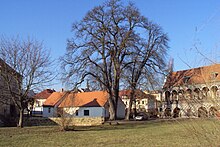Ulmus laevis
| Ulmus laevis | |
|---|---|
 |
|
| U. laevis, Česká Lípa, Czech Republic | |
| Scientific classification | |
| Kingdom: | Plantae |
| (unranked): | Angiosperms |
| (unranked): | Eudicots |
| (unranked): | Rosids |
| Order: | Rosales |
| Family: | Ulmaceae |
| Genus: | Ulmus |
| Species: | U. laevis |
| Binomial name | |
|
Ulmus laevis Pall. |
|
 |
|
| Distribution map | |
| Synonyms | |
|
|
Ulmus laevis Pall., variously known as the European white elm,fluttering elm, spreading elm, stately elm and, in the USA, the Russian elm, is a large deciduous tree native to Europe, from France northeast to southern Finland, east as far as the Urals, and southeast to Bulgaria and the Crimea; there are also disjunct populations in the Caucasus and Spain, the latter now considered a relict population rather than an introduction by man, and possibly the origin of the European population.U. laevis is rare in the UK, however its random distribution, together with the absence of any record of its introduction, has led at least one British authority to consider it native.
The species was first identified, as Ulmus laevis, by Pallas, in his Flora Rossica published in 1784.
Endemic to alluvial forest, U. laevis is rarely encountered at elevations above 400 m. Most commonly found along rivers such as the Volga and Danube, it is one of very few elms tolerant of prolonged waterlogged, anoxic ground conditions. Although not possessed of an innate genetic resistance to Dutch elm disease, the species is rarely infected in western Europe. The tree is allogamous and is most closely related to the American elm (U. americana).
Ulmus laevis is similar in stature to the wych elm, if rather less symmetric, with a looser branch structure and less neatly rounded crown. It typically reaches a height and breadth of > 30 m, with a trunk < 2 m d.b.h. The extensive shallow root system ultimately forms distinctive high buttresses around the base of the trunk. The bark is smooth at first, then in early maturity breaks into thin grey scales, which separate with age into a network of grey-brown scales and reddish-brown underbark, and finally is deeply fissured in old age like other elms. The leaves are deciduous, alternate, simple ovate with a markedly lop-sided base, < 10 cm long and < 7 cm broad, comparatively thin, often almost papery in texture and very translucent, smooth above with a downy underside. The leaves are shed earlier in autumn than other species of European elm. However, the tree is most reliably distinguished from other European elms by its long flower stems, averaging 20 mm. Moreover, the apetalous wind-pollinated flowers are distinctively cream-coloured, appearing before the leaves in early spring in clusters of 15-30; they are 3–4 mm across. The fruit is a winged samara < 15 mm long by 10 mm broad with a ciliate margin, the single round 5 mm seed maturing in late spring. The seeds have a generally high rate of germination, 45–60% for Serbian trees examined by Stilinović.
...
Wikipedia
